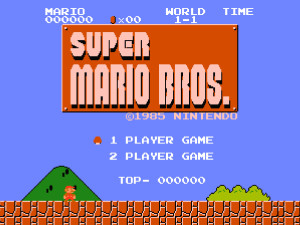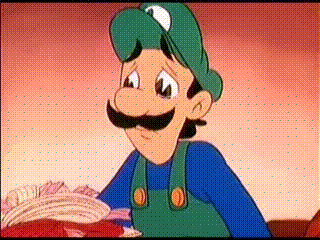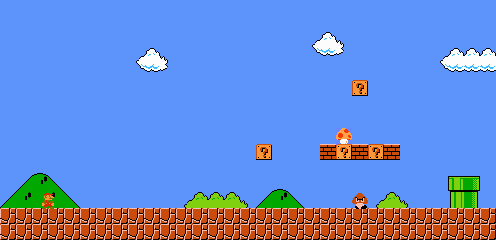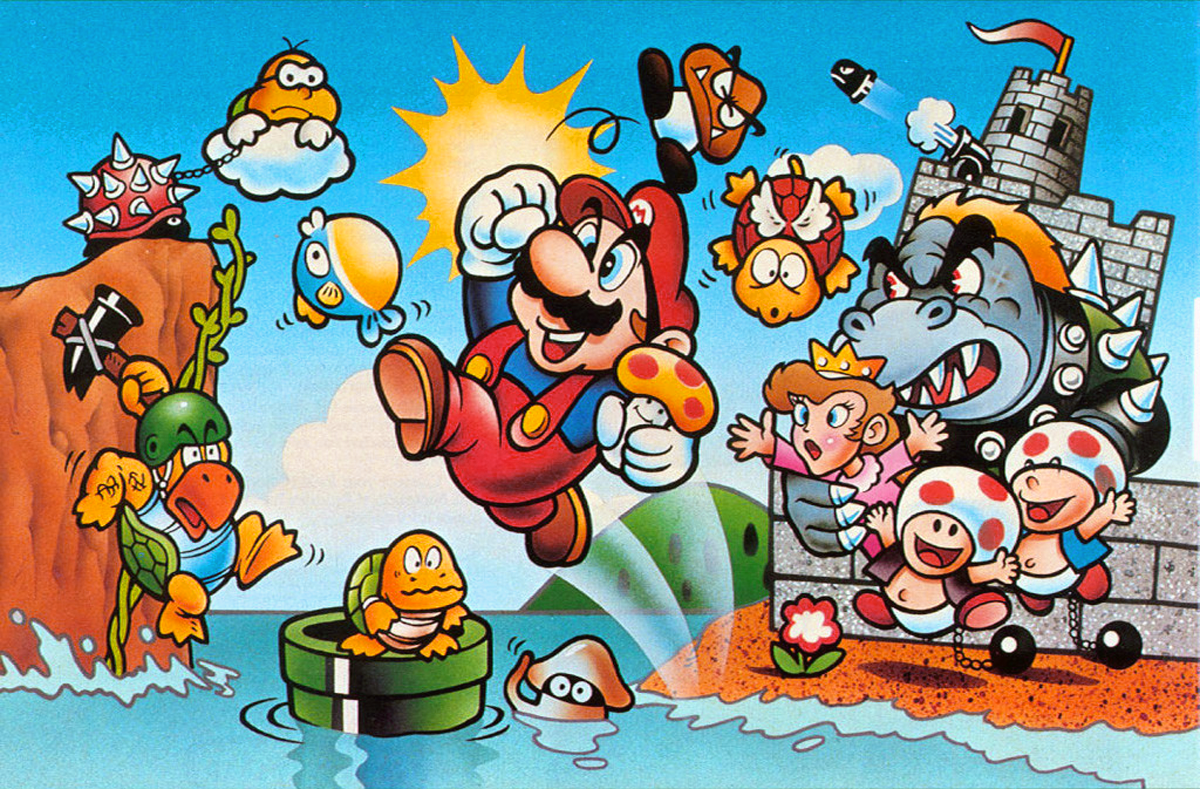Here’s a bold statement – World 1-1 of Super Mario Bros. is the greatest level to ever grace a video game. There, I said it, and I’ll brook no argument to the contrary. Well that was easy. Oh crap, I still have a word count to hit.
Ahem.
For many of us of a certain generation, Super Mario Bros was probably the first video game we ever played. It’s possible that there were others, but since the Nintendo Entertainment System (the NES as the cool kids call it) came with Super Mario Bros. as a pack in game, then it was exceedingly likely that the first thing your new Nintendo ever showed you was this:

Let us begin. There are a couple of things that this screen doesn’t show that is important. Thing number 1 is that Luigi, the default choice for player 2 and little brothers everywhere isn’t here. The smart money is on the notion that his inclusion would be a gross over-complication. Remember, this is likely one of the very first video game screens that most people ever saw. Arcades were one thing, but Nintendo was really in the process of creating a whole new language to communicate what games were supposed to be. In that case, there’s no need to add extraneous things like the douche in the green. I mean let’s be honest – Luigi is a loser also ran. (I look forward to your letters.)

But back to something that people would miss if it was gone – that start screen from 30 years ago. As you may or may not recall, none of the face buttons did anything except Start and Select. The screen though didn’t give you any prompt whatsoever to let you know what you were supposed to do. This is actually the first bit of “game” that you actually solve as a player on the NES.
I’ll explain. At their core what makes a game fun to a certain extent is something called the “Mastery Loop.” That’s a sexy little psychological feedback loop where a person first encounters a problem within the context of a system, learns the skill needed to overcome that system, and then applies that. Basically it allows you to get the feeling that you have mastery over that particular system. The more you do it, the better you get at that specific skill, which makes you feel good.
For players confronted with that Start Screen, the answer to their question of, “How do I start the game?” is answered right on the controller. Same to the question of, “How do I select 2 Player Game?” Cute, but it’s worth the explanation because that it begins to define the language that Nintendo wanted to use with the NES. “Start” starts a game, and “Select” usually brings up or changes some kind of option. Now there are outliers, but for most of the NES library, the game starts when you hit “Start,” and the first time you figured it out, your little kid brain felt just a little bit like you were a genius.
While it seems that I digress, the fact that the World 1-1 starts on that start screen means that as far as I am concerned it is a fundamental part of it.
Let’s take a quick look at 1-1 now, shall we?

The first chunk is probably one of the most iconic in gaming, and here it is:
 There are a few things that are about to happen here for the first time player. First, you’re probably going to die. You see on the front screen there is nothing that lets on what any of the buttons do. If a player has gotten this far then they are well on their way to knowing that the buttons do something, but there’s nothing here that tells them that “A” will make Mario jump. But the first time player is about to learn some very important life lessons in this very first section.
There are a few things that are about to happen here for the first time player. First, you’re probably going to die. You see on the front screen there is nothing that lets on what any of the buttons do. If a player has gotten this far then they are well on their way to knowing that the buttons do something, but there’s nothing here that tells them that “A” will make Mario jump. But the first time player is about to learn some very important life lessons in this very first section.
Number 1 – a Goomba will kill you dead. Press the arrow to the right and Mario will run off, but that Goomba there, that motherfucker has probably made more kids cry than The Dark Crystal. Unlike Start, that little dude exists so that you learn to jump. If the player doesn’t know how to jump, then they will never get past this guy. Here’s the thing that makes it interesting – anything could be used there. Hell, there’s a pipe to the right there that does a good job for teaching a jump, but that Goomba is adversarial. He’ll kill you faster than NBC kills quality television. But when he does it creates a feeling of, “Oh no you didn’t,” which in turn engenders a need to do it again.
Number 2 – Dying isn’t the end of the world. That’s right, in spite of what the rest of the game would lead you to believe, the universe of Super Mario Bros. doesn’t want to you fail (unless you’re Luigi, at which point nothing can possibly stop it). It fact, you have extra chances even to get it right. “Go ahead and experiment,” the game more or less tell you, since the price of failure is exceedingly small.
Number 3 – Jump dammit. That and physics, it teaches you both. Okay, so once the player has worked out which button makes lil’ Mario jump and they do it, they feel good. But, the designer of the game Shigeru Miyamoto had other things that he wanted you to know. That’s why all those other things are there that aren’t just Goomba shaped.
When you start the game you’re small Mario, which in the world of SMB means that you cannot break bricks. This will quickly be learned if you bump on the bricks while trying to jump over that original Goomba. If on the off chance you jump, get bounced by the bricks and hit the Goomba on top, you’ve just learned how to end the little bastard. This first encounter with bricks also teaches that sometimes other things will pop out of bricks and question mark boxes. That first thing is the mushroom, which is unfortunately Goomba shaped, which gets us to the next point:
Number 4 – Not everything will kill you. Those bricks you see floating around actually exist to teach the player that the Super Mushrooms are good for you. Satoru Iwata (former President of Nintendo) in an interview, said:
“…hit a block above you, a mushroom will spring out and you’ll get a shock. But then you’ll see that it’s going to the right so you’ll think: “I’m safe! Something strange appeared but I’m okay!” But of course when it goes against a pipe up ahead, the mushroom will come back!” The bricks then make it impossible for the player to easily avoid that mushroom, and. “even if you panic and try to jump out of the way, you’ll hit the block above you. Then just at the instant where you accept that you’re done for, Mario will suddenly shake and grow bigger! You might not really know what’s just happened, but at the very least, you’ll realize that you haven’t lost the turn.”








